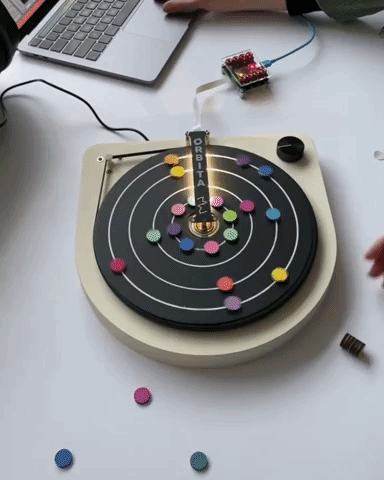Evolution of Orbita
Hi everyone! We’ve been building fun & quirky music controllers since 2016. Four years ago we had a synesthetic colour picker idea that turned colour into sound. This is the story of an upcoming device we’re excited to launch soon on Kickstarter.
🖌️ From workshop to the lab
The ideas for our devices are born from the workshops, installations and performances we do. TouchMe and Playtron were born that way and so is our soon-to-be-released Orbita. 4 years before Orbita, there was Pipette (also briefly named Tone). It was a handheld sensor designed by Aglaya Demidenko that could read colours and turned them into sound. For example, we could empty a back of colourful sweets on the table and play the colours of the candy through Pipette.
We previously had been turning objects into sounds, but we fell in love with the idea of making sounds from colours, so we kept playing with the idea in our studio and even mounted it to a turntable.
💫 From the lab to the museum
For our exhibition at the Parisian Centre Pompidou we used the same sensor, but attached it to a stick above rotating discs. Visitors could grab colourful elements and place them on the discs and hear the sound. We named it ЭЛЕКTRON since it was inspired by the movement of the universe’s most basic elements. Colours would turn into sound and shapes into rhythmic patterns.

💿 From the museum to a music video
The next iteration of the idea was called Tone and it’s featured in the music video of producer & Playtronica co-founder OMMA. It was a slightly more lightweight version of ЭЛЕКTRON, still featuring the turntables and the sensor. The video also featured other Playtronica devices.
🍭 From the video to the record player
We started thinking about how to make this experience available to more people, so we collaborated with Ackeem Ngwenya to create Tritone in 2019. It was a 3-channel scanner mounted on an adjustable stand, so any turntable could be used for turning colours into sound.

🪐 From the turntable to Kickstarter
Not everyone has a vinyl player at home, so we decided to take the idea of Tritone and combine it with a turntable ourselves and so Orbita was born. The design is actually inspired by clocks more than turntables and you’re able to place the Orbita upright, like a wall clock, so more people can see what you’re doing. You place magnets on the disk which are mapped to sound: it’s like creating your own planetary system of synesthesia.
It also adds a level of tactility to the experience, especially when compared to Pipette: you place the magnets on the disc, you can hold the the turntable to slow it down and feel the motion of the spinning motor inside.
The design went through many iterations: you can see some shots below.


🐣 Join the early bird list
Curious? Be the first to hear about when we go live on Kickstarter and get an early bird discount. We’ll let you know more about the design process, how you can use Orbita, how artists are using the device, and more. Join now!

